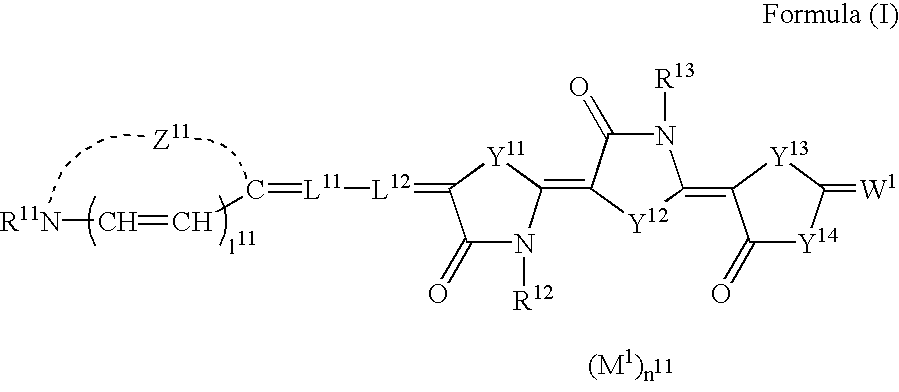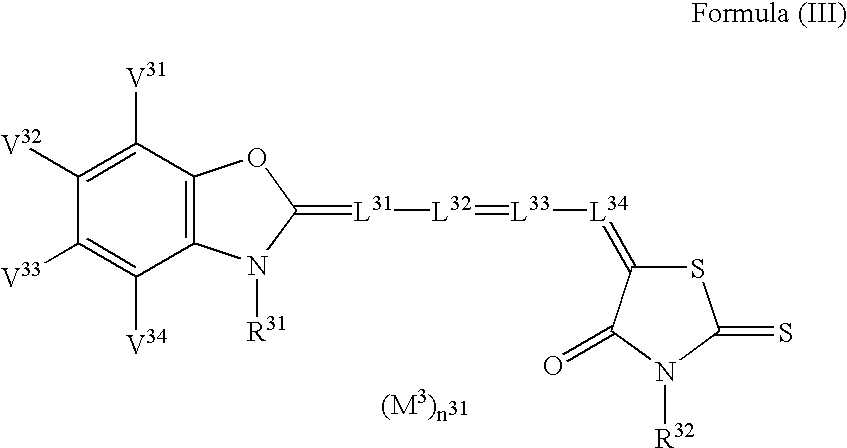Silver halide photographic light-sensitive material
a silver halide, light-sensitive technology, applied in the field of silver halide photographic light-sensitive materials, graphic arts, can solve the problems of reducing sensitivity, affecting processing stability, and reducing air oxidation of the developing country, and reducing the sensitivity of the developing country
- Summary
- Abstract
- Description
- Claims
- Application Information
AI Technical Summary
Benefits of technology
Problems solved by technology
Method used
Image
Examples
preparation example 2
Synthesis of Exemplary Compound II-4
In an amount of 2.48 g of 4-oxo-5-[2-[2-[3-(2-sulfoethyl)-2(3H)-benzoxazolidene]ethylidene]butylidene]-2-thiox othiazolidin-3-ylacetic acid was mixed with 2.5 g of dimethyl sulfate and heated at 130.degree. C. for 60 minutes with stirring. After returned to room temperature, the viscous reaction mixture was added with isopropyl ether, stirred and left standing, and the supernatant was removed by decantation. The residue was added with 1 g of 4-oxo-2-thioxothiazolidin-3-ylacetic acid, successively added with 10 ml of pyridine and 1 ml of triethylamine, mildly refluxed by heating for 20 minutes and then crystallized by cooling. The precipitates were taken by filtration and washed with an ethanol solvent. The obtained crude crystals were recrystallized from a methanol solvent to obtain 0.8 g of a dye that is Exemplary Compound II-4. The absorption maximum wavelength of the dye in a methanol solution was 611 nm.
example 1
In this example, silver halide photographic light-sensitive materials satisfying the requirements of the present invention (Samples 3, 4, 6, 9, 10, 12 and 14 to 22) and comparative silver halide photographic light-sensitive materials (Samples 1, 2, 5, 7, 8, 11 and 13) were prepared and evaluated. Production methods of emulsions and non-photosensitive silver halide grains used for the production of those silver halide photographic light-sensitive materials will be explained first, and then the method for producing the silver halide photographic light-sensitive materials and evaluations of them will be explained.
>
K.sub.3 TrCl.sub.6 (0.005%) and (NH.sub.4) 3 [RhCl.sub.5 (H.sub.2 O)] (0.001%) used for Solution 3 were prepared by dissolving powder of each in 20% aqueous solution of KCl or 20% aqueous solution of NaCl and heating the solution at 40.degree. C. for 120 minutes.
Solution 2 and Solution 3 in amounts corresponding to 90% of each were simultaneously added to Solution 1 maintaine...
example 2
Samples were prepared in the same manner as in Example 1 except that carboxymethyltrimethythiourea compound or dicarboxymethyldimethylthiourea, which is a tetra-substituted thiourea compound, was used instead of the sodium thiosulfate used for chemical sensitization of Emulsion A in the same molar amount as sodium thiosulfate. The samples having the characteristics of the present invention showed good performances as in Example 1.
PUM
| Property | Measurement | Unit |
|---|---|---|
| optical density | aaaaa | aaaaa |
| aspect ratio | aaaaa | aaaaa |
| optical density | aaaaa | aaaaa |
Abstract
Description
Claims
Application Information
 Login to View More
Login to View More - R&D
- Intellectual Property
- Life Sciences
- Materials
- Tech Scout
- Unparalleled Data Quality
- Higher Quality Content
- 60% Fewer Hallucinations
Browse by: Latest US Patents, China's latest patents, Technical Efficacy Thesaurus, Application Domain, Technology Topic, Popular Technical Reports.
© 2025 PatSnap. All rights reserved.Legal|Privacy policy|Modern Slavery Act Transparency Statement|Sitemap|About US| Contact US: help@patsnap.com



